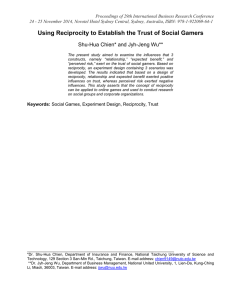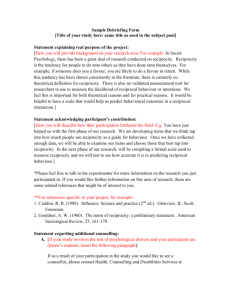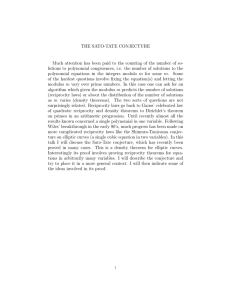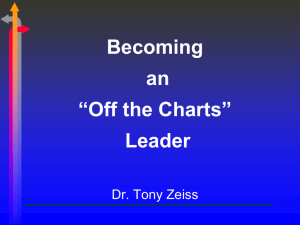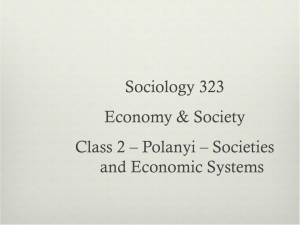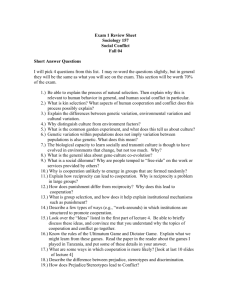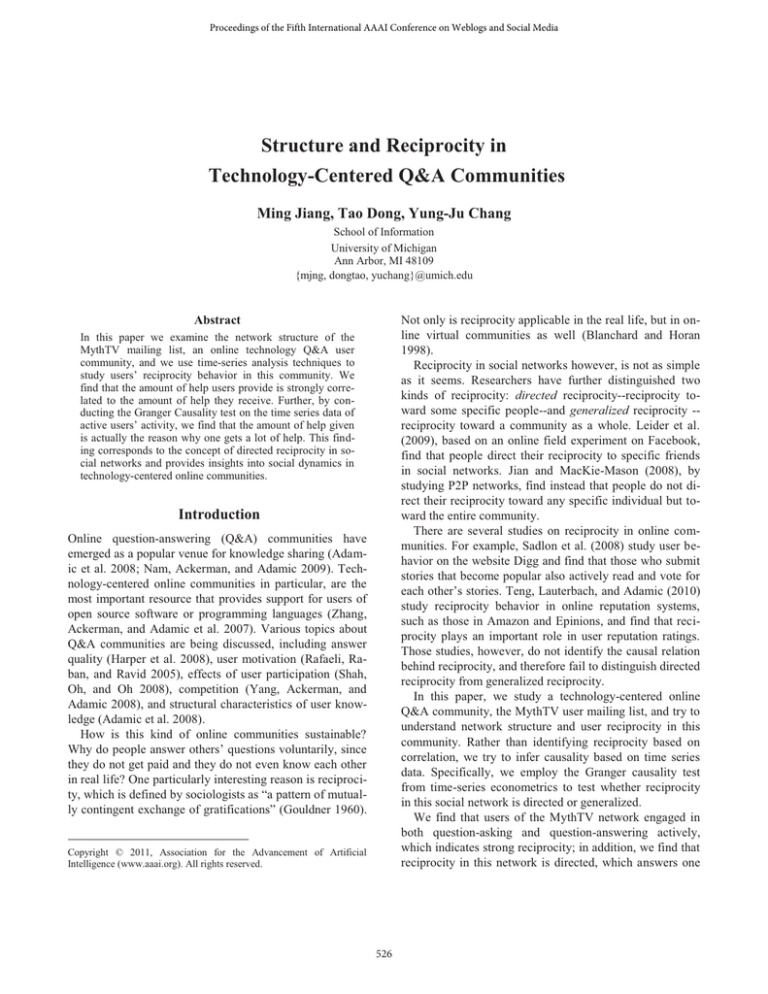
Proceedings of the Fifth International AAAI Conference on Weblogs and Social Media
Structure and Reciprocity in
Technology-Centered Q&A Communities
Ming Jiang, Tao Dong, Yung-Ju Chang
School of Information
University of Michigan
Ann Arbor, MI 48109
{mjng, dongtao, yuchang}@umich.edu
Not only is reciprocity applicable in the real life, but in online virtual communities as well (Blanchard and Horan
1998).
Reciprocity in social networks however, is not as simple
as it seems. Researchers have further distinguished two
kinds of reciprocity: directed reciprocity--reciprocity toward some specific people--and generalized reciprocity -reciprocity toward a community as a whole. Leider et al.
(2009), based on an online field experiment on Facebook,
find that people direct their reciprocity to specific friends
in social networks. Jian and MacKie-Mason (2008), by
studying P2P networks, find instead that people do not direct their reciprocity toward any specific individual but toward the entire community.
There are several studies on reciprocity in online communities. For example, Sadlon et al. (2008) study user behavior on the website Digg and find that those who submit
stories that become popular also actively read and vote for
each other’s stories. Teng, Lauterbach, and Adamic (2010)
study reciprocity behavior in online reputation systems,
such as those in Amazon and Epinions, and find that reciprocity plays an important role in user reputation ratings.
Those studies, however, do not identify the causal relation
behind reciprocity, and therefore fail to distinguish directed
reciprocity from generalized reciprocity.
In this paper, we study a technology-centered online
Q&A community, the MythTV user mailing list, and try to
understand network structure and user reciprocity in this
community. Rather than identifying reciprocity based on
correlation, we try to infer causality based on time series
data. Specifically, we employ the Granger causality test
from time-series econometrics to test whether reciprocity
in this social network is directed or generalized.
We find that users of the MythTV network engaged in
both question-asking and question-answering actively,
which indicates strong reciprocity; in addition, we find that
reciprocity in this network is directed, which answers one
Abstract
In this paper we examine the network structure of the
MythTV mailing list, an online technology Q&A user
community, and we use time-series analysis techniques to
study users’ reciprocity behavior in this community. We
find that the amount of help users provide is strongly correlated to the amount of help they receive. Further, by conducting the Granger Causality test on the time series data of
active users’ activity, we find that the amount of help given
is actually the reason why one gets a lot of help. This finding corresponds to the concept of directed reciprocity in social networks and provides insights into social dynamics in
technology-centered online communities.
Introduction
Online question-answering (Q&A) communities have
emerged as a popular venue for knowledge sharing (Adamic et al. 2008; Nam, Ackerman, and Adamic 2009). Technology-centered online communities in particular, are the
most important resource that provides support for users of
open source software or programming languages (Zhang,
Ackerman, and Adamic et al. 2007). Various topics about
Q&A communities are being discussed, including answer
quality (Harper et al. 2008), user motivation (Rafaeli, Raban, and Ravid 2005), effects of user participation (Shah,
Oh, and Oh 2008), competition (Yang, Ackerman, and
Adamic 2008), and structural characteristics of user knowledge (Adamic et al. 2008).
How is this kind of online communities sustainable?
Why do people answer others’ questions voluntarily, since
they do not get paid and they do not even know each other
in real life? One particularly interesting reason is reciprocity, which is defined by sociologists as “a pattern of mutually contingent exchange of gratifications” (Gouldner 1960).
Copyright © 2011, Association for the Advancement of Artificial
Intelligence (www.aaai.org). All rights reserved.
526
aspect of motivation of user contribution in this community: I help people today because I might need help from
people in the future.
Data Analysis
Network Characteristics
The Mythtv-users mailing list is functionally similar to
other technical forums such as the Java Forum studied in
Zhang, Ackerman, and Adamic (2007). However, our bowtie analysis of the Mythtv expertise network revealed an interesting structural difference from the Java Forum where
most of the participants only posted questions, while a
much smaller fraction of participants were responsible for
answers.
Bowtie structure analysis, first used to study the structure of the Web (Broder, et al. 2000), is useful to illustrate
the structure and connectivity of a directed network. A
bowtie structure divides a network into 6 components: 1)
the strongly connected core (SCC) in which every node
can reach every other node, 2) the IN component in which
nodes only have one-way links to the nodes in the core, 3)
the OUT component in which nodes only have one-way
links from the core, 4) tendrils which are nodes connected
to either nodes in the IN component or the OUT component, but not to those in the core, 5) tubes which are nodes
connecting the IN component and the OUT component but
do not belong to the core, and 6) disconnected nodes.
The Dataset
MythTV users communicate mainly through the mythtvusers mailing list1. According to Huh, Newman, and Ackerman (2011), the mailing list was devoted to answering
technical questions about troubleshooting and tailoring the
MythTV system, and because we observed that there was
very little casual chatting and general discussions, it is our
assumption that an initial message is a question and replies
to that message are potential answers.
We crawled the online archive of the mailing list consisting all of the 32326 messages posted between October
13, 2009 and November 4, 2010, and stored the data in a
database. Table 1 shows the data fields each message was
parsed into.
msg_id
reply_id
author_name
subject
body
timestamp
The identifier of the message
The identifier of the initial message
that this message replies to. If this
message is an initial message, then the
reply_id is the same as the msg_id.
The name of the message author
The subject of the message
The content of the message
The date and time the message is
posted
Table 1: Data fields of a parsed message
The dataset contains 1650 unique usernames, and 5298
threads of email messages. The daily traffic of the mailing
list in our dataset is 83.5 messages and 13.7 threads in average.
Following the concept of the community expertise network proposed by Zhang, Ackerman, and Adamic (2007),
we constructed a directed network of users. Specifically,
User A receives an indegree from User B when User A
replies to User B’s initial message (assumed as a question).
This type of network not only captures the interactions between users but also allows higher-level analysis of community structure and reciprocity behavior.
In order to do time-series analysis, we took a crosssectional sample of our data every two weeks in a cumulative manner, and then generated 28 networks for each time
period. In our data analysis, the Bowtie Structure analysis
was based on the network of sampled in the latest time period, while the reciprocity analysis examined all 28 networks as a time series.
1
Figure 1: Bowtie structure of MythTV network, compared with
Java Forum and the Internet.
Figure 1 compares the bowtie structure of the MythTV
network with that of the Java Forum network (as reported
in Zhang, Ackerman, and Adamic 2007) and of the Web
(as reported in Broder, et al. 2000). We have several interesting observations from these results. First, the MythTV
network has a much larger Strongly Connected Core
(35.8% of the nodes) than that of the Java Forum (12.3%)
as well as the Web (27.7%). This result indicates that, as
compared to the Java Forum, there are remarkably more
users in the MythTV network who both ask and answer
questions. Secondly, although the category of “users who
only ask questions (nodes in the IN component)” is about
1.7 times more than the category of “those who only an-
http://www.gossamer-threads.com/lists/mythtv/users/
527
information about future values of Y. And consider here
that X and Y refer to indegree and outdegree in our network.
Mathematically, to test against the null hypothesis that X
does not Granger-cause Y, we first construct a univariate
vector auto-regression (VAR) of variable Y (the regression
of Y based on its lagged value):
yt=a0+a1yt-1+…+amyt-m+ εt
whereas only y with significant t-statistics is retained in
this regression, m is the maximum time lag, and ε is the
random error.
Next, we extend this equation with lagged value of X:
yt=a0+a1yt-1+…+amyt-m+ bpxt-p+…+bqxt-q+ εt
whereas only y with significant t-statistics is retained in
this regression, provided that collectively they add explanatory power to the regression according to an F-test. p is
the shortest, and q is the longest lag length for which the
lagged value of x is significant. The null hypothesis is accepted if and only if, no lagged values of x are retained in
the regression.
To utilize this method, we used the time series data generated from the MythTV network. We took a crosssectional sample of our network every two weeks, and thus
we had 28 networks for each time period. Then we calculated the indegree and outdegree for each user in each network. For users who had not yet registered the email list by
each time point, we treated their degrees as zeros. Thus we
had a panel data for all users over 28 time periods.
In our time series model we used the indegree and outdegree data of the first 50 most active users (with rankings
based on the sum of their indegree and outdegree), since,
according to the degree distribution, the top 10% most active users contributed more than 90% of the total content.
We then took the average of those users’ indegrees and
outdegrees, since the Granger test required time series vectors, and we were more interested in the community aggregate than in individual behavior. In addition, we assumed
that the response time for reciprocity behavior was a
month; therefore we set the time lag parameter to 2.
swer questions (nodes in the OUT component)” in the
MythTV network, the difference is actually a lot smaller
than that in the Java Forum. Moreover, the IN component
of the MythTV network is much smaller than that of the
Java Forum, suggesting that the proportion of pure question-askers is much smaller than that in the Java Forum.
The above results of bowtie structure analysis imply
that, in comparison to functionally similar technical Q&A
forums, MythTV users were more engaged with each other
in the community, and notably fewer users managed or
chose to only receive help from the community without
making any contribution. In the next section, we further
investigate this phenomenon from the perspective of reciprocity.
Reciprocity
In our MythTV network, indegree and outdegree of the
nodes in the network are defined as the number of unique
people one person helps (i.e., replies/answers) in their
email threads, and the number of unique people from
whom one person receives help in all of his or her threads
by our dataset construction.
In this network, we find that indegree and outdegree of
users are strongly correlated (Pearson correlation, r =
0.5036, p < 0.001). We interpret this to mean that users
who answer more questions get more answers, based on
the Q&A-exclusive nature of this network.
We do not know, however, the direction at which one
factor causes the other yet from this correlation. There are
two possible explanations. If high indegree causes high
outdegree, this corresponds to directed reciprocity (Leider
et al. 2009): I have helped many people in the past, they
have either received my help, or observed my effort, and
now they are directing their efforts toward helping me
when I need assistance (or from an alternative, but equivalent perspective: some people helped me before so in response, I am helping those specific people); on the other
hand, if high outdegree causes high indegree, this corresponds to generalized reciprocity (Jian and MacKie-Mason
2008): many people helped me before, so I’m now helping
a lot of other, non-specific, people.
In order to find out the causal relation between indegree
and outdegree, we employed a one time-series statistical
method widely used in empirical macroeconomics, called
Granger causality (Granger 1969). It has also been used in
areas outside of economics, such as neural science
(Kamiński et al. 2001), and psychology (Bressler et al.
2008). The Granger causality test is a statistical hypothesis
test for determining whether one time series is able to forecast another. A time series X is said to Granger-cause Y if it
can be shown, usually through a series of t-tests and F-tests
on lagged values of X, with lagged values of Y also included, that those X values provide statistically significant
Equation
Indegree
Outdegree
Excluded
Outdegree
Indegree
χ2
1.4182
7.8153
p-value
0.234
0.005
Table 2: Granger Causality test for indegree and outdegree
We found through the Granger Causality test results (see
Table 2) that the null hypothesis that Indegree does not
Granger-causes Outdegree is rejected (p = 0.005), while
the null hypothesis that Outdegree does not cause Grangercauses Indegree cannot be rejected (p = 0.234). Therefore
we drew the conclusion that the reciprocity in the MythTV
528
network is directed: generosity towards others earns generosity from them.
Bressler, S., Tang, W., Sylvester, C., Shulman, G., and Corbetta,
M. Top-Down Control of Human Visual Cortex by Frontal and
Parietal Cortex in Anticipatory Visual Spatial Attention. Journal
of Neuroscience, 2008; 28 (40): 10056-10061.
Broder, A.; Kumar, R.; Maghoul, F.; Raghavan, P.; Rajagopalan,
S.; Stata, R.; Tomkins, A.; et al. 2000. Graph Structure in the
Web. Computer Networks 33(1-6): 309-320.
Gouldner, A. W. 1960. The Norm of Reciprocity: A Preliminary
Statement. American Sociological Review 25(2):161-178.
Granger, C. W. 1969. Investigating Causal Relations by Econometric Models and Cross-Spectral Methods. Econometrica 37 (3)
: 424–438.
Harper, F. M.; Raban, D.; Rafaeli, S.; and Konstan, J. A. 2008.
Predictors of Answer Quality in Online Q&A Sites. In CHI ’08:
Proceeding of the Twenty-sixth Annual SIGCHI Conference on
Human Factors in Computing Systems, 865–874. New York, NY,
USA: ACM.
Huh, J.; Newman, M. W.; and Ackerman, M. S. 2011. Supporting
Collaborative Help for Individualized Use. To appear in Proceedings of the Twenty-ninth Annual SIGCHI Conference on Human
Factors in Computing Systems. Vancouver, Canada: ACM.
Jian, L.; and MacKie-Mason, J. K. 2008. Why Share in Peer-toPeer Networks?. In Proceedings of 10th International Conference
on Electronic Commerce (ICEC) ’08, 4:1--4:8. Innsbruck, Austria: ACM.
Kamiński, M., Ding, M., Truccolo, W. A., and Bressler, S. L.
2001. Evaluating causal relations in neural systems: Granger causality, directed transfer function and statistical assessment of significance. Biological Cybernetics 85(2): 145-157.
Leider, S., Möbius, M. M., Rosenblat, T., and Do, Q. 2009. Directed Altruism and Enforced Reciprocity in Social Networks.
Quarterly Journal of Economics, 124(4):1815-1851
Nam, K., Ackerman, M. S., and Adamic, L. 2009. Questions in,
knowledge in?: a study of naver's question answering community.
In Proceedings of the 27th International Conference on Human
Factors in Computing Systems (CHI '09). ACM, New York, NY,
USA, pp. 779-788.
Rafaeli, S., Raban, D. R., and Ravid, G. 2005. Social and economic incentives in Google Answers. In ACM Group 2005 Conference, ACM.
Sadlon, E., Sakamoto, Y., Dever, H. J., Nickerson, J. V. 2008.
The Karma of Digg: Reciprocity in Online Social Networks. In
Proceedings of the 18th Annual Workshop on Information Technologies and Systems.
Shah, C., Oh, J. S. & Oh, S. 2008. Exploring characteristics and
effects of user participation in online Q&A sites. First Monday,
13 (9).
Teng, C., Lauterbach, D., and Adamic L. 2010. I rate you. You
rate me. Should we do so publicly? 3rd Workshop on Online Social Networks, Boston, MA.
Yang, J., Adamic, L. and Ackerman, M. S. 2008. Competing to
Share Expertise: The Taskcn Knowledge Sharing Community. In
Proceedings of The Second International Conference on Weblogs
and Social Media, 161-168. Menlo Park, Calif.: AAAI Press.
Zhang, J., Ackerman, M. S., and Adamic, L. 2007. Expertise
Networks in Online Communities: Structure and Algorithms. In
Proceedings of the 16th International Conference on World Wide
Web, 221-230. New York, NY, USA: ACM.
Conclusion
In this paper we study the network characteristics of a
technology-centered online Q&A community (the MythTV
mailing list). We find that the MythTV network is more
connected and reciprocal than some technology-centered
communities (for example, Java Forum). Also, we show,
by looking at the correlation of indegree and outdegree,
that reciprocity behavior is prevalent in the network. Finally, by using time-series analysis techniques, we are able to
show that reciprocity in this community is actually more
directed: people tend to direct their help to those who
helped them before.
Our study has important implications for understanding
social dynamics in online communities, especially technology-centered ones. Reciprocity is indeed the driving force
behind user contribution and cooperation. The reason why
users answer questions initially is that they can expect to
get help from other people later on. This explains the existence and sustainability of such communities.
Since our research is a preliminary study of applying
time-series analysis techniques in economics to social networks, it has a few limitations. First, we only look at the
reciprocity behavior in aggregate since we take the average
indegree and outdegree for most active users; we do not
study the behavior patterns for individual users. Second,
drawing conclusions about reciprocity based on the Granger test, though better than simple correlation or regression, can still be questioned. If both indegree and outdegree are driven by a common third process with a different
time lag, one might still accept the alternative hypothesis
of Granger causality. Moreover, due to the community we
chose, we were only able to access data from a limited period of time (1 and half years); different conclusion might
be drawn if the data set spanned 3 or more years.
Further work could be done to extend the study of user
behavior to other kinds of online Q&A forums and mailing
lists to see if the reciprocity pattern is robust across different communities, and identify the community traits that
foster reciprocity. In addition, text analysis of email transaction content could be done to provide qualitative evidence for the validity of our conclusion.
References
Adamic, L. A.; Zhang, J.; Bakshy, E.; and Ackerman, M. S. 2008.
Knowledge Sharing and Yahoo Answers: Everyone Knows
Something. In Proceeding of the 17th International Conference
on World Wide Web, 665–674. New York, NY, USA: ACM.
Blanchard, A. L.; and Horan, T. 1998. Social Capital and Virtual
Communities. Social Science Computer Review 16(3): 293-307
529


